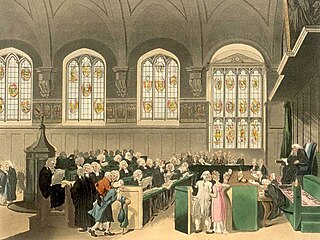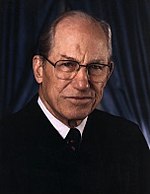Collateral estoppel (CE), known in modern terminology as issue preclusion, is a common law estoppel doctrine that prevents a person from relitigating an issue. One summary is that, "once a court has decided an issue of fact or law necessary to its judgment, that decision ... preclude[s] relitigation of the issue in a suit on a different cause of action involving a party to the first case". The rationale behind issue preclusion is the prevention of legal harassment and the prevention of overuse or abuse of judicial resources.

Estoppel is a judicial device in common law legal systems whereby a court may prevent or "estop" a person from making assertions or from going back on his or her word; the person being sanctioned is "estopped". Estoppel may prevent someone from bringing a particular claim. Legal doctrines of estoppel are based in both common law and equity. It is also a concept in international law.
A declaratory judgment, also called a declaration, is the legal determination of a court that resolves legal uncertainty for the litigants. It is a form of legally binding preventive by which a party involved in an actual or possible legal matter can ask a court to conclusively rule on and affirm the rights, duties, or obligations of one or more parties in a civil dispute. The declaratory judgment is generally considered a statutory remedy and not an equitable remedy in the United States, and is thus not subject to equitable requirements, though there are analogies that can be found in the remedies granted by courts of equity. A declaratory judgment does not by itself order any action by a party, or imply damages or an injunction, although it may be accompanied by one or more other remedies.
Festo Corp. v Shoketsu Kinzoku Kogyo Kabushiki Co., 535 U.S. 722 (2002), was a United States Supreme Court decision in the area of patent law that examined the relationship between the doctrine of equivalents and the doctrine of prosecution history estoppel.
Prosecution history estoppel, also known as file-wrapper estoppel, is a term used to indicate that a person who has filed a patent application, and then makes narrowing amendments to the application to accommodate the patent law, may be precluded from invoking the doctrine of equivalents to broaden the scope of their claims to cover subject matter ceded by the amendments. Although primarily a U.S. term, questions of whether, or the extent to which the prosecution history should be relevant for determining the extent of protection of a patent also arise outside the U.S.
The exhaustion doctrine, also referred to as the first sale doctrine, is a U.S. common law patent doctrine that limits the extent to which patent holders can control an individual article of a patented product after a so-called authorized sale. Under the doctrine, once an authorized sale of a patented article occurs, the patent holder's exclusive rights to control the use and sale of that article are said to be "exhausted," and the purchaser is free to use or resell that article without further restraint from patent law. However, under the repair and reconstruction doctrine, the patent owner retains the right to exclude purchasers of the articles from making the patented invention anew, unless it is specifically authorized by the patentee to do so.

Mallinckrodt, Inc. v. Medipart, Inc., 976 F.2d 700, is a decision of the United States Court of Appeals for the Federal Circuit, in which the court appeared to overrule or drastically limit many years of U.S. Supreme Court precedent affirming the patent exhaustion doctrine, for example in Bauer & Cie. v. O'Donnell.
Quanta Computer, Inc. v. LG Electronics, Inc., 553 U.S. 617 (2008), is a case decided by the United States Supreme Court in which the Court reaffirmed the validity of the patent exhaustion doctrine. The decision made uncertain the continuing precedential value of a line of decisions in the Federal Circuit that had sought to limit Supreme Court exhaustion doctrine decisions to their facts and to require a so-called "rule of reason" analysis of all post-sale restrictions other than tie-ins and price fixes. In the course of restating the patent exhaustion doctrine, the Court held that it is triggered by, among other things, an authorized sale of a component when the only reasonable and intended use of the component is to engage the patent and the component substantially embodies the patented invention by embodying its essential features. The Court also overturned, in passing, that the exhaustion doctrine was limited to product claims and did not apply to method claims.
Lear, Inc. v. Adkins, 395 U.S. 653 (1969), is a decision of the U.S. Supreme Court overturning the doctrine of licensee estoppel and holding that public interest considerations require that licensees be free to challenge the validity of possibly spurious patents under which they are licensed. This entailed the overruling of Automatic Radio Mfg. Co. v. Hazeltine Research, Inc. and prior cases that it had reaffirmed.
United States v. Glaxo Group Ltd., 410 U.S. 52 (1973), is a 1973 decision of the United States Supreme Court in which the Court held that (1) when a patent is directly involved in an antitrust violation, the Government may challenge the validity of the patent; and (2) ordinarily, in patent-antitrust cases, "[m]andatory selling on specified terms and compulsory patent licensing at reasonable charges are recognized antitrust remedies."

Aro Manufacturing Co. v. Convertible Top Replacement Co., 365 U.S. 336 (1961), is a United States Supreme Court case in which the Court redefined the U.S. patent law doctrine of repair and reconstruction. The decision is sometimes referred to as Aro I because several years later the Supreme Court readdressed the same issues in a second case in 1964 involving the same parties—Aro II.
United States v. General Electric Co., 272 U.S. 476 (1926), is a decision of the United States Supreme Court holding that a patentee who has granted a single license to a competitor to manufacture the patented product may lawfully fix the price at which the licensee may sell the product.
Medtronic, Inc. v. Mirowski Family Ventures, LLC, 571 U.S. 191 (2014), is a case of the Supreme Court of the United States that deals with civil procedure, and specifically with the question of the burden of proof required in pursuing declaratory judgments.
Ex parte Wood, 22 U.S. 603 (1824), was a United States Supreme Court case in which the Court held that a patent could not be repealed based on summary proceedings without the opportunity for a jury trial. The case exemplifies a tradition in early 19th century United States patent caselaw in which patents were regarded specifically as an absolute property right to exclusive use of the invention, rather than requiring a balancing between public and private interests.
Morton Salt Co. v. G.S. Suppiger Co., 314 U.S. 488 (1942), is a patent misuse decision of the United States Supreme Court. It was the first case in which the Court expressly labeled as "misuse" the Motion Picture Patent/Carbice tie-in defense to a charge of patent infringement and created the present blanket remedy in infringement cases of unenforceability of the misused patent. The decision re-emphasized that misuse can be found without finding an antitrust violation.
Motion Picture Patents Co. v. Universal Film Mfg. Co., 243 U.S. 502 (1917), is United States Supreme Court decision that is notable as an early example of the patent misuse doctrine. It held that, because a patent grant is limited to the invention described in the claims of the patent, the patent law does not empower the patent owner, by notices attached to the patented article, to extend the scope of the patent monopoly by restricting the use of the patented article to materials necessary for their operation but forming no part of the patented invention, or to place downstream restrictions on the articles making them subject to conditions as to use. The decision overruled The Button-Fastener Case, and Henry v. A.B. Dick Co., which had held such restrictive notices effective and enforceable.
Walker Process Equipment, Inc. v. Food Machinery & Chemical Corp., 382 U.S. 172 (1965), was a 1965 decision of the United States Supreme Court that held, for the first time, that enforcement of a fraudulently procured patent violated the antitrust laws and provided a basis for a claim of treble damages if it caused a substantial anticompetitive effect.
Henry v. A.B. Dick Co., 224 U.S. 1 (1912), was a 1912 decision of the United States Supreme Court that upheld patent licensing restrictions such as tie-ins on the basis of the so-called inherency doctrine—the theory that it was the inherent right of a patent owner, because he could lawfully refuse to license his patent at all, to exercise the "lesser" right to license it on any terms and conditions he chose. In 1917, the Supreme Court overruled the A.B. Dick case in Motion Picture Patents Co. v. Universal Film Mfg. Co.,
The Mercoid cases—Mercoid Corp. v. Mid-Continent Investment Co., 320 U.S. 661 (1944), and Mercoid Corp. v. Minneapolis-Honeywell Regulator Co., 320 U.S. 680 (1944)—are 1944 patent tie-in misuse and antitrust decisions of the United States Supreme Court. These companion cases are said to have reached the "high-water mark of the patent misuse doctrine." The Court substantially limited the contributory infringement doctrine by holding unlawful tie-ins of "non-staple" unpatented articles that were specially adapted only for use in practicing a patent, and the Court observed: "The result of this decision, together with those which have preceded it, is to limit substantially the doctrine of contributory infringement. What residuum may be left we need not stop to consider." The Court also suggested that an attempt to extend the reach of a patent beyond its claims could or would violate the antitrust laws: "The legality of any attempt to bring unpatented goods within the protection of the patent is measured by the antitrust laws, not by the patent law."
The reverse doctrine of equivalents is a legal doctrine of United States patent law, according to which a device that appears to literally infringe a patent claim, by including elements or limitations that correspond to each element or limitation of the patent claim, nonetheless does not infringe the patent, because the accused device operates on a different principle. That is, "it performs the same or a similar function in a substantially different way." It has been said that "the purpose of the 'reverse' doctrine is to prevent unwarranted extension of the claims beyond a fair scope of the patentee's invention."





